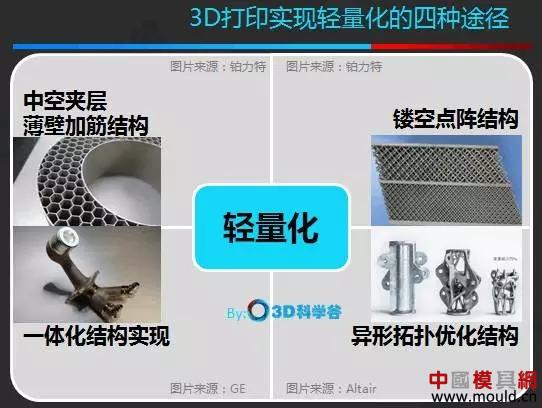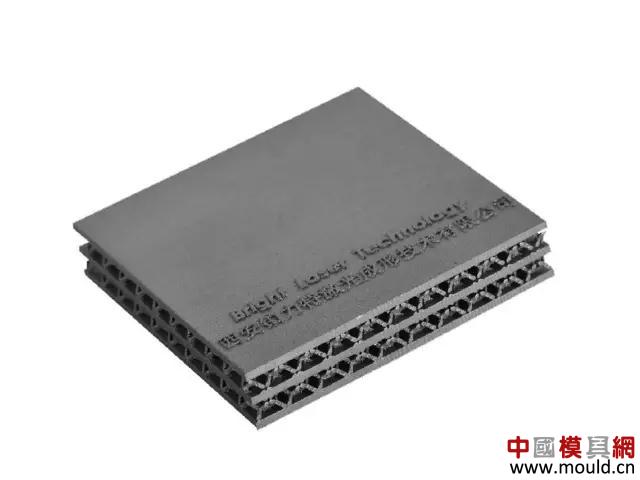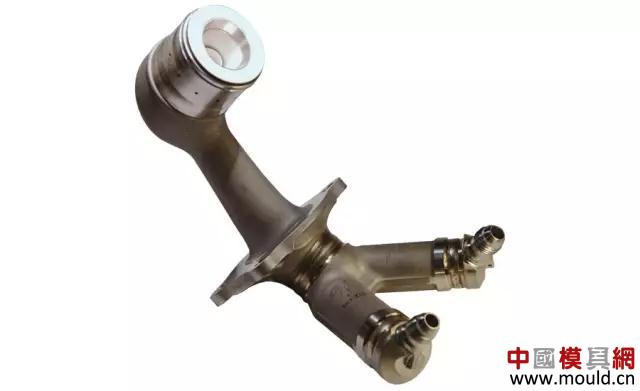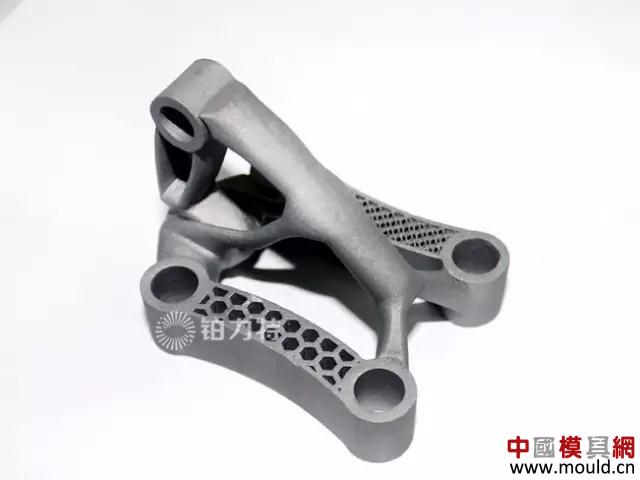The advantages of lightweight structures are not difficult to understand. Taking a car as an example, the weight is light, and it can bring about better maneuverability. The power of the engine output can produce higher acceleration. As the vehicle is light, the acceleration performance at the start is better, and the braking distance at the time of braking is shorter. Taking an aircraft as an example, lighter weight can improve fuel efficiency and load.
To achieve light weight, macroscopic levels can be achieved through the use of lightweight materials such as titanium alloys, aluminum alloys, magnesium alloys, ceramics, plastics, glass fibers, or carbon fiber composite materials. On the micro level, the use of materials such as high-strength structural steels can make the parts more compact and compact, and contribute to lighter weight.

3D printing brings about the feasibility of achieving lightweight through structural design. Specifically, there are four main ways for 3D printing to achieve lightweight through the structural design level: hollow sandwich/thin-wall reinforced structure, hollowed-out lattice structure, integrated structure implementation, and heterogeneous topology optimization structure.
Route 1: Hollow sandwich, thin-walled stiffened structure
Hollow sandwich thin-walled stiffened structures are usually composed of relatively thin panels combined with relatively thick cores. Under the bending load, the surface layer material mainly bears tensile stress and compressive stress. The core material mainly bears shear stress and also bears some compressive stress. The sandwich structure has the advantages of light weight, high bending rigidity and strength, strong anti-unsteading ability, fatigue resistance, sound absorption and heat insulation.

In the field of aviation, wind turbine blades, sports equipment, shipbuilding, train locomotives and other fields, a large number of sandwich structures are used to reduce weight.
If aluminum and titanium alloys are used as skins and core materials, this sandwich structure is called a metal sandwich structure. In the 3D printing process, Xi'an Plitter uses a sandwich structure to realize rapid and lightweight components, and a designed sandwich structure. It has good dispersion effect on the tensile and compressive loads directly acting on the external skin. Thin-walled structures (for example, with a wall thickness of 1 mm or less) can also contribute to weight reduction; sandwiches and similar structures can be used as radiators on parts. The application greatly improves the heat exchange area of ​​the parts and improves the heat dissipation efficiency.
Route 2: Hollow lattice structure
The hollow lattice structure can achieve the perfect balance of engineering strength, toughness, durability, statics, dynamics performance and manufacturing costs. Through a large number of periodic replication of a single cell for design and manufacturing, by adjusting the relative density of the lattice, cell shape, size, material and loading rate in a variety of ways, to adjust the structural strength, toughness and other mechanical properties.
The three-dimensional hollow structure has a high degree of spatial symmetry. It can evenly decompose the external load and ensure the bearing capacity while achieving weight reduction. In addition to engineering requirements, the hollow matrix has spatial pores (adjustable pore size). In the application of implants, it can facilitate the integration of the human body (tissue) and the implant.

Hollow lattice cell design has a high degree of flexibility. According to the environment used, lattice cells with different shapes, sizes, and porosity can be designed. Xi'an Plitter has made continuous attempts in this regard: in the areas where the strength requirements of components are high, the density of lattice cells is adjusted to be larger, and hollow lattice cells with high structural strength are selected; in regions with high demand for component weight reduction To add a hollowed out lattice structure with a large amount of lightness, hollow structures can be arranged not only regularly but also randomly to form irregular pores. In addition, the hollow structure can also exhibit gradient transitions of variable density and thickness to accommodate the gradient strength requirements of the overall structure.
3D Science Valley found it interesting that many of our concerns are about how the lattice structure can achieve the intensity and flexibility we need. Some extremely niche research also includes how to obtain the needed "vulnerability." Previously, the British Lightweight Project Coalition was studying how to crush the lattice structure. The application scenario is that when the return capsule enters the earth's air layer, changes in pressure and speed pose great challenges to the mechanical structure of the capsule. An ultra-light density of 0.4 k/cm3 is obtained by additive manufacturing of the lattice structure of Ti-6Al-4V, and such a structure needs to be designed to be "crushed" under a certain pressure. 3D printing opens up a new field for mechanical performance performance of hollow lattice cells.
Route 3: Implementation of an integrated structure
3D printing can be integrated printing of parts originally combined with multiple components. This not only realizes the integral structure of the parts, but also avoids the connection structures (flanges, welds, etc.) that existed when the original multiple parts were combined, but also Helps designers break through the shackles to achieve functionally optimized designs.

The realization of the integrated structure not only brings advantages of light weight, but also reduces the need for assembly and opens up a feasible space for enterprises to improve their production efficiency. A typical case in this area is GE's development of its fuel injectors through continuous optimization, testing, and optimization for more than 10 years of exploration, reducing the number of nozzle parts from more than 20 to one. The integration of the structure through 3D printing not only improves the problem of easy overheating and carbon deposition of the injector, but also increases the service life of the injector by five times and improves the performance of the LEAP engine.
Path 4: Special Topology Optimization Structure
Topology optimization is an important means to shorten the process of additive manufacturing design. Topological optimization is used to determine and remove materials that do not affect the rigidity of the part. The topology method determines the best material distribution within a definite design area: including boundary conditions, pretensions, and loads.

Topology optimization redistributes material from the original part and often achieves functional optimization based on weight reduction requirements. After the topological optimization of the special-shaped structure through the simulation analysis to complete the final modeling, these designs often can not be processed through the traditional processing methods, and can be achieved through 3D printing. Usually, the 3D printed products and the parts manufactured by the traditional process still need to be assembled together. Therefore, the design of the parts must also consider the design of the joint parts of the two parts.
The above four kinds of 3D printing structures are one of the directions for realizing the lighter weight of machinery. It is a systematic project to reduce the weight of machinery, from the design optimization and manufacturing of each key component to the development and application of lightweight materials. Explore the road that is indispensable.
Tie- bared efficient aerosol transforming mechanism
Multi- core pulling modes for choosing
Self- developed efficient, energy- saving servo system
Low pressure and high pressure patent for options, suitable for different products
Efficient plasticized screw with high length- to- diameter ration( Design by Germany)
Specified Injection Moulding process for Bi- section pipes
Patented center clamping structure
Double- cylinders for moving, single cylinder for injection
Related Products:Plastic Water Pipe Making Machine,Pipe Making Machine.
EKII/J Large Volume Injection Moulding Machine
Large Volume Injection Moulding Machine, pipe fitting injection moulding machine, Pipe Fitting Injection Machine,Plastic Water Pipe Making Machine,Pipe Making Machine
Ningbo Shuangma Machinery Industry Co., Ltd , https://www.bolemachinery.com
![<?echo $_SERVER['SERVER_NAME'];?>](/template/twentyseventeen/skin/images/header.jpg)